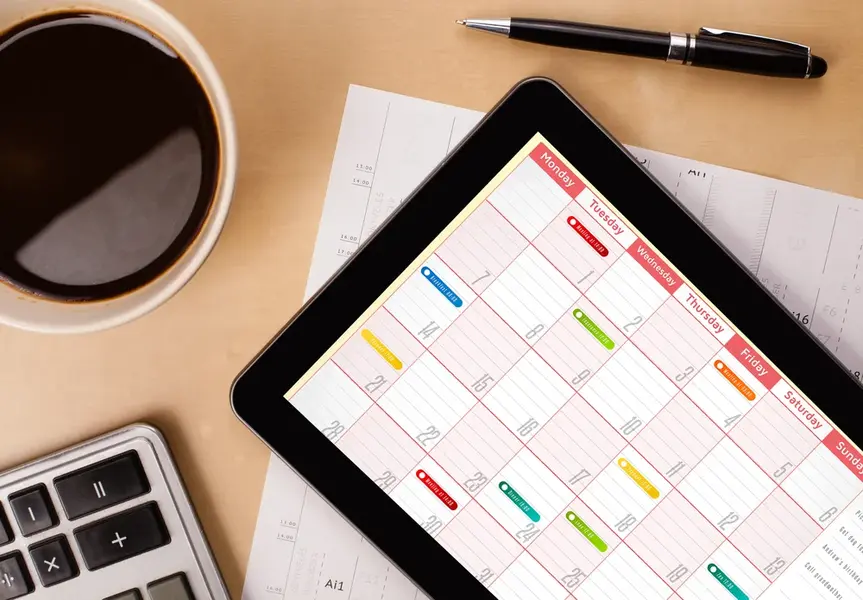For months on end, life at home can feel very unstructured. And there’s a certain allure about that. However, adding a little more structure can be beneficial. Numerous studies have shown that routine is beneficial to children’s mental health and their capacity to feel secure in knowing what will happen next. It can provide them a sense of control, which is beneficial during stressful situations.
Creating a study timetable, on the other hand, can be more difficult than we believe. Not only must you guide your kids to prioritise the subjects and courses they need to study in a given period of time, but also juggle additional obligations like family, friends, and enjoyment. In the end, though, with a little planning and effort, you’ll have no trouble to guide the young learners to make a schedule and to achieve all of their academic objectives.
8 Steps to Plan Your Productive Learning Schedule

Step 1: Set Goals
It will be easier to create and manage the schedule if you know what your kids want to achieve in the end. This will also help you identify areas that your kids need to focus on.
- Short-term goals might include passing a test in a week or memorizing a presentation in 10 days. For these projects, break up the tasks by day.
- Long-term goals might include getting into a certain school or college, winning in lego robotics competition, or mastering a language. For these, break down the goals by week and month to make them more manageable.
Make sure your kids know exactly how much time he/she has for each of these goals. Write the end-date down and calculate how many days, weeks, and months are left. For example, what is the deadline for a singing competition, or when are the exams?

Step 2: Determine the 'Non-Negotiables'
The majority of people make the error of starting a timetable by eagerly filling it with studies. This is a huge blunder. By putting in the study blocks first, students get overconfident and overcommit to hours that they will never be able to keep. This frequently leads to feelings of tension, overwhelm, and eventual abandonment of the entire process of adopting a timetable.
Instead, we recommend that you encourage your child to make a list of all the things they enjoy doing during the week and the ones they will not compromise on. We next ask them to choose a time slot for these activities that they would most likely devote. A list might look something like this:
- Basketball: Mondays, 6pm – 7:30pm and Sundays 2pm – 4pm
- Robotics & Coding: Tuesdays and Thursdays, 7pm – 8pm, Saturdays 3pm – 6pm
- Seeing friends: Weekends, 11am – 6pm
- Online games – PUBG: Mondays, 8pm – 9:30pm
- Social media: Daily, 8:30pm – 9:15pm
Of course, it’s impossible to predict each of your child’s leisure activities in advance, but a reasonable estimate is a good place to start. We advise students to move on to step 4 once they have identified the important times for leisure activities.

Step 3: Put in the Fun Stuff First
After you’ve identified all of your kid’s extracurricular and leisure activities, the following step is to incorporate them into your kids’ study schedule. Make sure your kids agree with all the times and activities you put in.

Step 4: List All the Neccesary Subjects and Activities
Perhaps the first step in creating the study schedule is to list all of the subjects and courses your kids need to study for. Putting all the obligations on paper will help your kids get a better idea of what they really have to do. If they have specific exams to study for, list these instead of courses.

Step 5: Put Study in the Gaps
Finally, you will notice that the study schedule contains numerous vacant areas or gaps. These are the moments when the youngster can study throughout these gaps. Instead of assigning specific assignments, they could simply designate certain time slots for learning. That way, they’ll have a clear idea of how much time they should devote to their studies, and when they sit down for that study block, they’ll be able to prioritise their assignments and focus on finishing their homework and revision tasks.

Step 6: Consider Schedule Time for Breaks
Nobody enjoys working for long periods of time without taking a break. It may be a good idea to set a scheduled break when your children become restless or hungry. Perhaps you should take a morning snack break and an afternoon exercise or play break after lunch. You may discover good moments for these breaks when you first get started, and you can then start scheduling them into your day.
With a timetable in mind, the first rule is to arrange breaks. Young children can concentrate for up to 30 minutes at a time. Older children can work for 45 to 60 minutes without needing to take a 10-minute break. Cites from the Pomodoro Technique, which claims that taking periodic pauses is good for your brain and mood. You’ll be able to concentrate better and learn more. As everyone’s skill and capability differs, try to see what works best for your children.

Step 7: Create Rewards System
Consider implementing a sticker reward chart for young learners. The steps are straightforward: Each time your child achieves a goal, place a sticker on the chart. Some parents reward their children for reaching key milestones. (For example, she can earn one sticker for sticking to the schedule completely.) A tiny toy or fresh book is awarded every ten stickers. See why reward system is importance for kids.
You can get printable reward charts on the internet, or you can design your own at home. Please be certain that the prizes for your children are what they most desire. This will encourage your children to stick to the timetable and complete their tasks cheerfully on a daily basis. See how to set it up in an effective ways.
Step 8: Track Progress
Check into it with your children after a few weeks or a month to see how far they’ve progressed. If the study schedule you set isn’t producing the desired results, try adjusting the times.
Keeping a schedule is vital not only for children, but for the entire family. Parents should respect their children’s school and homework time and ensure that the home is calm when they need to concentrate. The ideal option is to have a white board where everyone can keep track of schedules.

Step 9: Stick to the Schedule
Children require a lot of motivation. Pay attention to your child’s efforts and improvement. Try something like, “You put a lot of effort into it,” or “Writing is difficult, but I can see how much you’re improving with practise!” Praise for effort will encourage your child to complete new and difficult chores. Use these extra ideas to keep youngsters interested, especially when they’re learning online.
We can change a student’s perspective of a study schedule by reversing the process of creating one (fun stuff first, study second). It is no more a ‘study-timetable’ around which life revolves, but rather a life-timetable around which study revolves. This indicates that they are prioritising the activities they enjoy while still making time to learn. As a result, kids are more ready to study at those times since they know they will not be abandoning the activities they actually enjoy. This empowers kids by giving them a sense of control over their priorities and autonomy.
By going through this process with your child, he or she will learn that there is always time to enjoy life while still having enough time to study if we plan ahead of time. We discover that we have more time than we imagined by laying out all of the specific actions. It’s also vital to remember that this study schedule should be utilised as a suggestion rather than a rule book. The goal is not to commit 100% to it to the letter and live life in such rigid time frames. It’s a ‘success’ if your child follows the schedule 60% of the time.
This is top-notch! I wonder how much effort and time you have spent to come up with these informative posts.